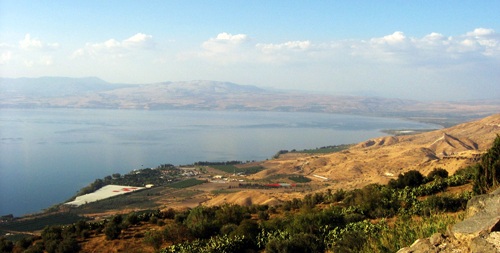
The Sea of Galilee is the only major body of fresh water in Israel. In the Old Testament it is called the Sea of Kinnereth (Num 34:11; Jos 12:3' 13:27). The origin of this name is uncertain. It may be named after the town of Kinnereth (Deut 3:17; Jos 11:2; 19:35; 1 Ki 15:20). Alternatively, the town may have derived its name from the lake; kinnor, means 'harp' in Hebrew, which is the shape of the lake (it is possible to see the entire lake from a number of points from the heights above both the eastern and western shores). It is called variously in the New Testament: Sea of Galilee (Matt 4:18; 15:29; Mk 1:16; 7:31), Sea of Tiberias (Jn 6:1; 21:1), and Lake Gennesaret (Lk 5:1).
Open Map ☰
Open Close-Up Map ☰
Open Panaromic View ☰

Sea of Galilee from the Golan Heights, looking north towards Mount Hermon (center) and Capernaum (left on the far shore).
The lake is 21km from north to south and 12km at its broadest and its mean water level at 210m below sea level. Bound by the steep slopes of the Bashan/Golan Heights on the east, the lake has always been subject to sudden gusts that can whip up the tranquility of the lake into turmoil within minutes, as described in Mt 8:24 & 14:24-32. Its major sources of water come from the Jordan feeding it from the north. The southern section of the Jordan flows from the southern end (just west of center) of the lake.
The presence of a number of hot-springs in the region feed the lake with warm currents that encourage the proliferation of the 22 species of fish found in the lake. Fishing has, therefore, always been an important industry around the lake. From that industry Jesus called out some of his earliest disciples to become 'fishers of men' instead.

From these shores Jesus called his first disciples."

The Sea of Galilee remains an important source of fresh fish today, and the so-called St Peter's Fish (tilapia) would have been a must-have meal for almost every tourist to modern Israel. Environmental stress and degradation, caused especially drought, made worse by the huge amounts of water siphoned off to feed Israel's voracious need for water and her so-called agricultural "miracle," are depleting and endangering the fish stock in the Sea of Galilee. E. g., the tilapia, Tristramella sacra, known popularly as Long Jaw, and was endemic to the Sea of Galilee, has not been seen since 1990; it was declared extinct in 2004. In 2013, the fish stock was so depleted that the government has had to intervene by injecting fresh fish stock into the sea (see, e.g., BBC News 18 Sept 2013).

Tristramella sacra, endemic to the Sea of Galilee, that has not been seen since 1990.

See also Fish.

Further Reading & Resources:
☰ John Goldingay, "Fishing on the Sea of Tiberias," Anvil 10.1 (1993): 9.

©ALBERITH
u080720lch